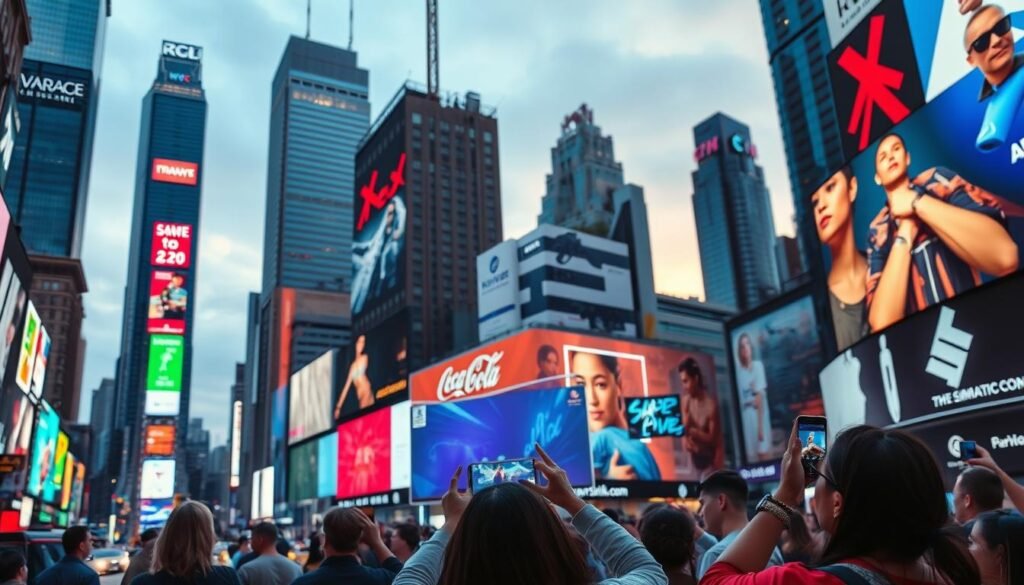A staggering 71% of consumers express a desire to shop more frequently if they could utilize augmented reality to visualize products in their own environment. This statistic underscores the pivotal role of augmented reality in marketing. It is transforming customer interactions with brands, evolving from a novelty to a critical necessity for businesses aiming to lead the market.
Introduction to AR Marketing
The rapid advancement of technology opens up immense possibilities for AR marketing. It empowers companies to craft immersive experiences that boost engagement and sales. The primary objective of augmented reality in marketing is to merge the physical and digital realms, offering customers a more interactive and tailored experience. This innovation is reshaping brand-audience connections, positioning AR marketing as a fundamental component of any successful marketing strategy.
Key Takeaways
- Augmented reality is changing the marketing landscape
- AR marketing can increase customer engagement and sales
- The Role of Augmented Reality in Marketing is to provide immersive experiences
- AR marketing is becoming a necessity for businesses
- AR can bridge the gap between the physical and digital worlds
- AR marketing is essential for any marketing strategy
Understanding Augmented Reality (AR) and Its Impact
Augmented Reality (AR) has seen a surge in popularity, transforming various sectors, including advertising. It overlays digital content onto the physical world, offering an interactive and immersive experience. This capability engages audiences in ways previously unimaginable. For deeper insights into AR’s role in education, visit this resource.
The Augmented Reality benefits are vast, with a standout advantage being its ability to deliver unique, engaging experiences. Brands can now create interactive ads that let customers try products virtually, boosting conversion rates. For example, showcases how AR enhances advertising by offering immersive experiences.
What is Augmented Reality?
Augmented Reality leverages a device’s camera to superimpose digital content onto the real world. This can include images, videos, or 3D models. AR finds applications in AR in advertising, education, and gaming.
The Evolution of AR in Technology
The development of AR has been swift, with notable strides in recent years. From basic to complex, interactive experiences, AR has evolved significantly. Today, it permeates sectors like retail, healthcare, and tourism.
Key Differences Between AR and Virtual Reality
AR and Virtual Reality (VR) are both immersive technologies but differ fundamentally. AR overlays digital content onto the real world, whereas VR creates a virtual environment. These distinctions significantly influence their applications, including in advertising and education.
How AR Transforms Customer Experience
Augmented Reality technology is transforming customer interactions with brands. It enables businesses to create immersive experiences through AR applications in marketing. These experiences leave a lasting impression. Enhancing customer experience is a core aspect of AR marketing. It allows customers to interact with products in a more personalized and interactive manner.
Through AR-powered product demonstrations, customers can explore products from every angle. This facilitates informed purchasing decisions. It boosts customer satisfaction and encourages repeat business.
Enhancing Product Visualization
AR applications in marketing enable businesses to offer interactive product experiences. This includes virtual try-on, 3D product demos, and interactive tutorials. Such experiences enhance customer engagement and drive sales.
Creating Interactive Brand Experiences
AR technology facilitates the creation of interactive brand experiences. This goes beyond traditional marketing methods. It includes AR-powered games, quizzes, and challenges that engage customers. These experiences foster stronger customer relationships and increase brand loyalty.
Augmented Reality Applications in Marketing
As Augmented Reality trends evolve, businesses are exploring new ways to use AR in marketing. This technology is reshaping how companies engage with customers, offering immersive experiences that boost engagement and conversion rates.
The adoption of AR in marketing is on the rise, with numerous brands integrating it into their strategies. AR applications in marketing are being utilized across various sectors, such as retail, real estate, and tourism. AR is being employed in several ways, including:
- Virtual try-on and product demonstrations
- Interactive brand experiences and events
- Virtual property tours and travel guides
These applications not only improve customer experiences but also offer businesses valuable insights and data. By embracing Augmented Reality trends, companies can maintain a competitive edge and foster growth.
As AR technology progresses, we anticipate even more groundbreaking AR applications in marketing. With its capacity to craft immersive and interactive experiences, AR is set to transform the marketing landscape.
The Benefits of AR for Brands
Augmented Reality (AR) has emerged as a crucial element in digital marketing, offering significant advantages for brands aiming to boost customer engagement and enhance brand visibility. By integrating AR into their marketing plans, companies can craft immersive experiences that captivate their audience and elevate sales conversion rates. The significance of AR in digital marketing stems from its capacity to deliver a distinctive, interactive experience, distinguishing brands from their rivals.
For example, brands can leverage AR to develop interactive product demos, enabling customers to engage with products in a more engaging and memorable fashion. This can be achieved through an Augmented Reality strategy that prioritizes immersive experiences. Such an approach enhances customer engagement and motivates customers to share their experiences, thus amplifying brand awareness.
Some of the primary advantages of AR for brands include:
- Enhancing customer engagement through interactive experiences
- Increasing brand awareness by fostering memorable and shareable experiences
- Driving higher sales conversion rates by offering a more immersive and interactive experience
As brands continue to explore AR’s potential in digital marketing, staying abreast of the latest trends and best practices is crucial. By visiting digital marketing resources, brands can acquire valuable insights into AR’s importance in digital marketing and develop an effective Augmented Reality strategy.
By embracing AR, brands can maintain a competitive edge and offer their customers unique, engaging experiences that yield tangible results. Immersive experiences are pivotal in unlocking AR’s full potential, positioning brands for success in the competitive digital marketing landscape.
Developing an AR Marketing Strategy
Creating an effective Augmented Reality strategy necessitates a deep understanding of marketing objectives and how AR can elevate customer engagement. It is crucial to align the AR strategy with the company’s goals, target audience, and brand identity. This alignment enables businesses to craft immersive experiences that foster customer interaction and boost brand awareness.
To forge a successful AR marketing strategy, companies must first identify their target audience and objectives. This entails grasping the needs and preferences of the target audience and determining how AR can fulfill those needs. For example, AR marketing campaigns can offer interactive product demonstrations, virtual try-on experiences, or immersive brand narratives.
- Choosing the right AR platforms and tools to support the campaign
- Creating engaging and interactive content that resonates with the target audience
- Measuring the success and ROI of the AR campaign to inform future marketing decisions
By integrating Augmented Reality into their marketing efforts, businesses can create innovative and memorable experiences. These experiences drive customer engagement and loyalty. An effective AR marketing strategy positions companies to outpace competitors and meet their marketing goals.
The Role of Social Media in AR Marketing
Social media is crucial in AR marketing campaigns, serving as a conduit to expand AR experiences and reach a broader audience. By merging Augmented Reality with social media initiatives, enterprises can forge engaging, interactive experiences. These efforts enhance customer interaction and amplify brand visibility.
Platforms like Facebook, Instagram, and Snapchat are at the forefront of AR features. They offer tools and resources for companies to craft and disseminate AR content. This includes filters, lenses, and effects.
Successful AR Campaigns on Social Media
- Facebook: AR marketing campaigns on Facebook have been successful in driving customer engagement and increasing brand awareness.
- Instagram: Instagram’s AR features have been used by businesses to create interactive and engaging experiences for their customers.
- Snapchat: Snapchat’s AR lenses have been used by businesses to create fun and interactive experiences for their customers.
By harnessing social media platforms and The Role of Augmented Reality in Marketing, businesses can devise impactful AR marketing campaigns. These campaigns are designed to boost customer engagement and enhance brand recognition.
Overcoming Challenges in AR Implementation
As businesses venture into AR marketing, they encounter several hurdles that can impede the successful integration of Augmented Reality technology. A major concern is the substantial development cost required for creating immersive AR experiences. This financial burden can be a significant obstacle.
Another critical challenge lies in the technological limitations of AR, which can impact the user experience. Technological advancements are continually evolving, yet businesses must remain current with these developments. This ensures that AR experiences are seamless and effective.
Addressing User Acceptance and Accessibility
To overcome these challenges, businesses must focus on user acceptance and accessibility. This can be achieved through several strategies:
- Conducting thorough market research to understand target audience needs
- Developing user-friendly AR experiences that are easy to navigate
- Ensuring accessibility across various devices and platforms
By addressing these challenges, businesses can unlock the full potential of AR marketing. They can create engaging, interactive experiences that enhance customer engagement and conversion.
The Future of Augmented Reality in Marketing
As technology advances, Augmented Reality trends are set to significantly influence marketing’s future. The Importance of AR in digital marketing is immense, poised to transform brand-customer interactions fundamentally.
The trajectory of AR in marketing is promising, with technological progress and emerging trends fueling expansion and creativity. Key areas to observe include:
- Improved accessibility and affordability of AR technology
- Increased adoption of AR in various industries, including retail and healthcare
- Enhanced user experience and engagement through interactive AR experiences
With AR technology’s ongoing evolution, we anticipate novel and groundbreaking applications of Augmented Reality trends in marketing. This will further underscore the Importance of AR in digital marketing. Brands that remain at the forefront of these trends will be well-positioned for success in the dynamic marketing environment.
Case Studies: Successful AR Marketing Campaigns

Augmented reality (AR) has become a pivotal tool in marketing, offering immersive and engaging experiences for consumers. Successful AR marketing campaigns have notably increased customer engagement and sales. Let’s examine a few instances where brands have successfully employed AR applications in marketing to meet their objectives.
Immersive Brand Experiences
Companies such as IKEA, Pepsi, and L’Oreal have pioneered innovative AR marketing campaigns. For example, IKEA’s Place App enables customers to visualize furniture in their homes before purchase, significantly enhancing the shopping experience through AR applications in marketing. This strategy has been crucial in boosting customer engagement and driving sales.
AR marketing campaigns have also been pivotal in creating interactive experiences. Pepsi’s AR Super Bowl Experience is a prime example, where viewers could engage in an AR game during the Super Bowl. This showcases AR’s potential in crafting engaging brand experiences.
Try-On AR Experiences
L’Oreal’s Makeup Try-On AR Experience allows customers to virtually try on makeup products, reducing the need for physical testers and enhancing the customer experience. This application of AR in marketing highlights how brands can effectively connect with their audience and drive sales through AR applications in marketing.
These case studies underscore the effectiveness of AR marketing campaigns in enhancing customer experience, increasing brand awareness, and driving sales. By integrating AR applications in marketing, businesses can maintain a competitive edge and achieve their marketing objectives.
Tools and Technologies for AR Marketing
As Augmented Reality technology advances, marketers now have a plethora of tools and technologies at their disposal. These range from well-known AR development platforms to specialized software for marketers. For a deeper dive into AR’s role in marketing, explore Augmented Reality in Marketing resources.
In the realm of AR in advertising, the objective is to identify the most suitable tools and technologies for each marketing objective. This might involve partnering with AR creators for bespoke solutions or leveraging existing software for interactive campaigns.
Popular AR Development Platforms
- ARKit
- ARCore
- Unity
Software Solutions for Marketers
Marketers can leverage software like ZapWorks or Wikitude to craft engaging AR experiences. These tools are designed to be user-friendly, even for those without extensive coding expertise.
Collaborating with AR Creators
Engaging with AR creators is crucial for marketers aiming to develop tailored AR solutions. Such collaborations ensure that the final product aligns with the marketer’s specific objectives and goals.
The Importance of User Experience in AR
In the realm of Augmented Reality (AR) marketing, the user experience stands as a pivotal factor in campaign success. As brands venture into the Augmented Reality benefits, they must focus on crafting engaging, interactive experiences. These experiences should resonate deeply with their target audience. This approach unlocks the true potential of AR marketing, leading to significant outcomes.
Creating user-friendly AR experiences is vital for capturing and retaining user interest. This can be achieved through the design of intuitive interfaces, clear instructions, and smooth navigation. By emphasizing user experience, brands can enhance user engagement, increase brand visibility, and ultimately, boost sales conversion rates.
- Keeping it simple and intuitive
- Using high-quality visuals and audio
- Providing interactive and immersive experiences
By adhering to these principles and prioritizing user experience, brands can develop impactful AR marketing campaigns. These campaigns yield tangible results and make a lasting impression on their audience.
Legal and Ethical Considerations in AR Marketing

As Augmented Reality (AR) becomes increasingly integral to marketing, it’s vital to examine its legal and ethical facets. The integration of AR in marketing transcends mere interactive experiences. It necessitates a commitment to respecting users’ privacy and safeguarding their intellectual property. The significance of AR in digital marketing is underscored by its capacity to elevate customer engagement. Yet, this must be harmonized with the imperative to protect users’ personal data.
Several critical factors come into play:
- Privacy concerns: AR technologies frequently necessitate access to users’ location data, camera, and other personal information.
- Intellectual property issues: AR experiences may incorporate copyrighted materials, such as images or music.
- Compliance with advertising standards: AR marketing campaigns must adhere to relevant regulations and guidelines.
By tackling these legal and ethical considerations, marketers can guarantee that their AR campaigns are not only impactful but also ethical and respectful of users’ rights. This is paramount for preserving consumer trust and averting potential legal complications. As the role of AR in digital marketing expands, prioritizing these considerations is essential. It ensures the creation of AR experiences that are both captivating and responsible.
Conclusion: The Future of AR in Marketing
Augmented Reality (AR) is revolutionizing how brands interact with their audience. It enhances product visualization and creates engaging brand experiences. This makes AR a crucial tool for marketers. As the digital landscape evolves, embracing AR will be essential for staying competitive.
The potential for AR in marketing is vast. Brands like IKEA, Pepsi, and L’Oreal have demonstrated its power. We can anticipate more immersive AR campaigns in the future. By integrating AR into their strategies, brands can enhance customer engagement, increase brand awareness, and boost sales.
The future of AR marketing hinges on brands’ ability to innovate continuously. By staying at the forefront of AR technology, marketers can craft unforgettable experiences. These experiences will captivate audiences and differentiate brands from competitors. It’s imperative for brands to adopt AR marketing campaigns and develop a robust Augmented Reality strategy now.
FAQ
What is Augmented Reality (AR) and how can it benefit marketing?
Augmented Reality (AR) overlays digital content, like images and 3D models, onto the real world. It enhances marketing by improving customer experiences and boosting engagement. AR lets customers interact virtually with products, increasing interest and purchase intent.
How does AR transform the customer experience?
AR revolutionizes customer experiences in several ways. It offers enhanced product visualization, interactive brand experiences, and personalized, immersive interactions. These elements create emotional connections and delight customers.
What are some of the key applications of AR in marketing?
AR transforms various marketing areas, including retail, real estate, and tourism. It enables customers to try on products, visualize home furnishings, and explore destinations virtually. This enhances the shopping, home design, and travel experiences.
What are the benefits of AR for brands?
AR benefits brands by increasing engagement, awareness, and sales conversion rates. It provides interactive experiences that connect brands with their audience. This differentiation helps drive more sales.
How can brands develop an effective AR marketing strategy?
Brands should identify their audience and goals first. Then, choose the right AR platforms and technologies. It’s crucial to measure campaign success and align AR with marketing objectives. Continuous optimization based on feedback and data is key.
What role does social media play in AR marketing?
Social media is vital for AR marketing, offering a platform for integrating AR experiences. Brands can use platforms like Instagram and Snapchat to create engaging AR campaigns. This amplifies brand awareness and customer engagement.
What are the challenges in implementing AR for marketing?
Implementing AR faces challenges like high costs, technological limitations, and user acceptance issues. Brands must find cost-effective solutions, stay updated with AR technology, and ensure user-friendly experiences.
What is the future of AR in marketing?
The AR marketing future is promising, with expected advancements and new opportunities. Brands that integrate AR effectively will gain a competitive edge. They will offer innovative experiences to their customers.

